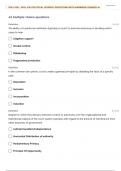Exam (elaborations)
An analysis of literary terms and figures of speech - SUBJECT TERMINOLOGY
- Module
- LITERATURE
- Institution
- AQA
A close look at various aspects of subject terminology- including metaphors, alliteration, the oxymoron, characterisation , pathetic fallacy illustrations of these by reference to works of literature
[Show more]












